Francesca and Henk-Jan's Backpacking Trip!
Tuesday, August 17, 2010
Sera, Sera (Whatever Will Be, Will Be) Monastery
Francesca and I had planned for the 17th of August to be an optional day. We knew we might have a chance to ‘be a Tibetan for a day,’ but since we’d seen the nomad family earlier this wasn’t terribly high on our priority list. Furthermore, our agency didn’t offer such a trip, forcing us to check other companies, which all told us they’d charge a lot and would have problems getting us a separate permit. Since we already knew it’d be hard to actually spend some more time with locals we asked Ray to make another stop in another village somewhere along the way to see some more Tibetans live their lives.
Instead of getting up terribly early we slept in, ordered breakfast in bed and didn’t meet Ray and Sam until 1:30 PM. Ray told us we had to take a taxi to the monastery of the day: Sera Monastery. A quick walk through the Muslim Quarter later we were by the side of the road, and soon found a taxi to take us to the designated location. Francesca asked me to take a picture of the highly valuable commodity all men in the quarter seem to be trading: cordyceps. Cordyceps is a caterpillar fungus that turns its host into a drone. After its death the fungus continues growing and in the process becomes a highly sought after ingredient of Tibetan traditional medicine. The street value of this stuff can be as much as $5000 per kilo!
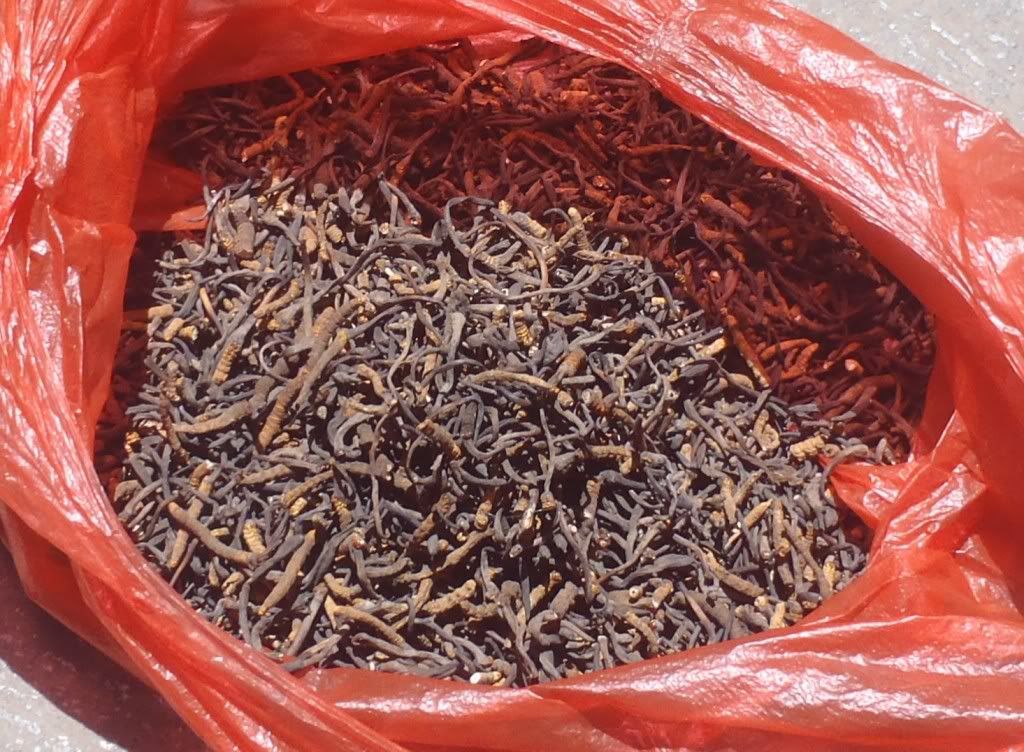
Sera Monastery would be the second of the three great Gelugpa university monasteries we’d be able to see on our trip through Tibet. The first one had been Drepung, the monastery we’d only walked past on our way to the Shoton Festival. Since this monastery has an intensely rich history that is only poorly told without proper introduction to Tibetan Buddhism, allow me to pull together some interesting information. Hopefully it’ll help you understand this intricate way of life.
From Francesca you learned that Princess Wencheng, one of King Songtsen Gampo’s wives, came to Tibet with a statue of Shakyamuni Buddha. It’s not known whether Buddhism had a large following at this time. It is however clear from Tibetan sources that some of his successors became ardent Buddhists. Francesca also told you that Songtsen Gampo also married a Nepalese Buddhist princess, Bhrikuti. Wiki: “By the second half of the 8th century he was already regarded as an embodiment of the bodhisattva Avalokitesvara. The successors of Songtsen Gampo were less enthusiastic about the propagation of Buddhism but in the 8th century, King Trisong Detsen established it as the official religion of the state. He invited Indian Buddhist scholars to his court. In his age the famous tantric mystic Padmasambhava (known as Guru Rinpoche in Tibet) arrived in Tibet according to the Tibetan tradition. At this early time also, from the south came the influence of scholars under the Pala dynasty in the Indian state of Magadha. They had achieved a blend of Mahayana and Vajrayana that has come to characterize all forms of Tibetan Buddhism.” According to Mahayana Buddhism one should to attain enlightenment whereas Vajrayana Buddhists strive to attain enlightenment as quickly as possible in this very life.
Obviously, with this many different sources to work with it was inevitable Tibetan Buddhism became divided. Several important Buddhists had their own ideas about the right paths to follow and started their own schools, propagating their truth. Since all Monasteries we are going to tell you about are directly influenced by the school they’re part of it will be necessary to explain a little about the four different branches of Tibetan Buddhism. Here follows a summary based on information from Wikipedia and Buddhism.about.com.
The Nyingma tradition is the oldest of the four major schools of Tibetan Buddhism. ”Nyingma" literally means "ancient," and is often referred to as the "school of the ancient translations" or the "old school" because it is founded on the first translations of Buddhist scriptures from Sanskrit into Tibetan, in the eighth century. It claims as its founder Guru Rinpoche, "The Beloved Master," the man that King Trisong Detsen brought to Tibet in the 8th century.
The Kagyupa School, also known as the "Oral Lineage" or “Whispered Transmission” school, primarily follows the Vajrayana or Tantric teachings. Kagyupa is best known for its system of meditation and practice called Mahamudra. Some accounts name Marpa "The Translator" (1012-1099) as the founder of the School, while others name Gampopa (1084-1161), also known as Dagpo Lhaje, who was a student of Marpa's disciple Milarepa, as the founder.
The Sakya tradition developed during the second period of translation of Buddhist scripture from Sanskrit into Tibetan in the late 11th century. It was founded by Drogmi, a famous scholar and translator. The School is also one of the Red Hat sects (named after the color of the hats the monks wear) along with the Nyingma and Kagyupa.
Finally, the Gelugpa Sect, also known as the Yellow Hat Sect (guess what color their hats are!), is a school of Buddhism founded by Lama Tsongkhapa (1357–1419), a philosopher and Tibetan religious leader. The Gelugpa School places great emphasis on monastic discipline and sound scholarship. Also, the Dalai Lamas come from the Gelugpa School. We’ll tell you more about the Dalai Lamas and their history in upcoming posts, so fret not! Besides, after this wave of information your heads must be spinning already. Let’s return to the matter at hand: our visit to Sera Monastery.
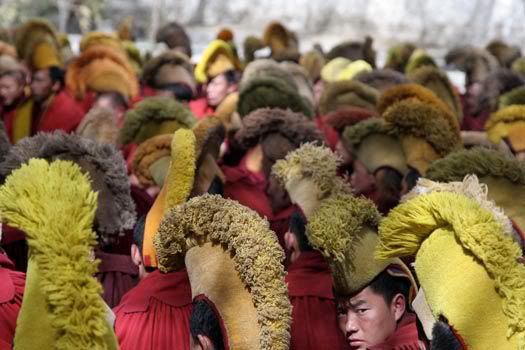
Whilst walking uphill towards the first interesting buildings Ray told us that one of Tsongkhapa’s eight disciples founded Sera in 1419. Sera Monastery became famous for its tantric teachings, while Drepung Monastery drew fame from its governing role. We learned that the name ‘Sera’ comes from the landscape surrounding the monastery, which in spring and summer is covered in wild roses (‘se ra’ in Tibetan). In earlier days the monastery had been home to over 5500 monks. Up until 2006 there were still about 1000 of them left, but some of them mysteriously disappeared, leaving Sera with only several hundred residing monks.

Sadly, the Monastery suffered greatly during the Cultural Revolution (thank you so much Mao Zedong!), losing several colleges and seeing hundreds of monks die at the hands of the Chinese. As with most other Monasteries, structures were rebuilt, but invaluable knowledge and artifacts still vanished from the earth forever.
Entering that first unassuming building the three of us were immediately blown out of the water by what we got to see. Several glass cages showcased these extremely intricate, colorful works of art. ‘Mandalas’ is what they are called, and they’re made from colored sand. Themes differ, but always involve some deities (sometimes up to 722!) or Buddhist teachings. Ray told us one mandala can take four monks up to five days to make. Interestingly, most sand mandalas are destroyed shortly after their completion. This is done as a metaphor of the impermanence of life. Just look at these pictures – can you begin to imagine how much work goes into these things?
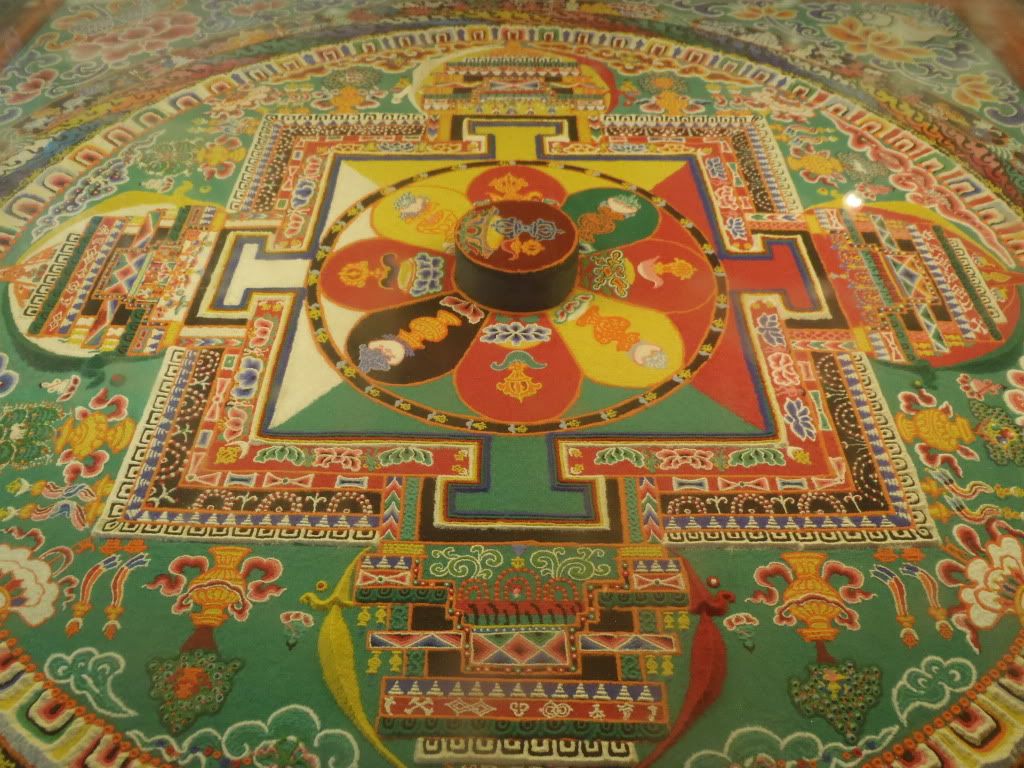
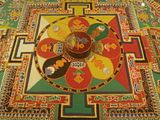

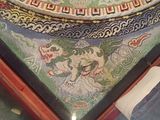
Inside the following building a father and son were hard at work. Most, if not all monasteries in Tibet have their own libraries, but only few monasteries still make their own books. Sera is one of those places where a traditional press house is still in use. Pages are copied by inking a piece of wood carved with the required text, pressing a piece of paper on and rolling over it with something hard to get everything printed properly. And boy, did they have that down to an art! They must have been doing a page every second. The texts they copied are either Buddha’s teachings or commentary on said teachings. Interestingly, the walls of the small building were lined entirely with racks and racks of inscribed wooden blocks. Quite impressive! Before exiting we also found a mural with a sword and a textbook as its centerpiece. Weird combination you’d say… Well, the sword is not used for fighting in the traditional way – instead, it’s to ‘cut’ ignorance from people and give them wisdom.
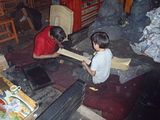
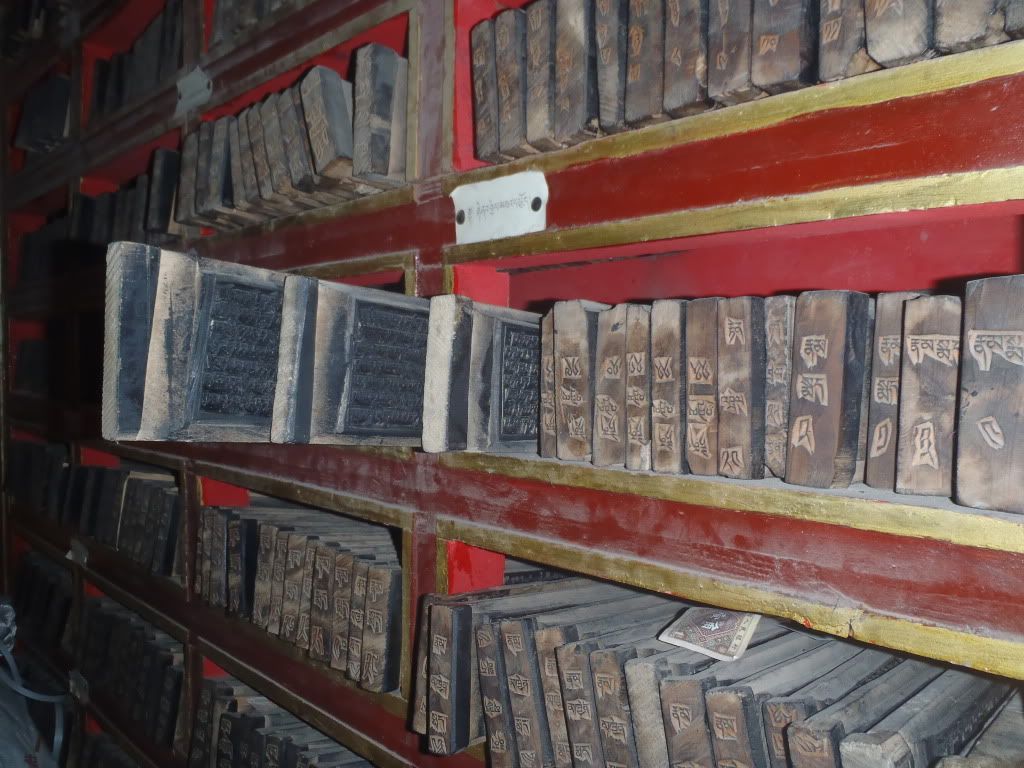
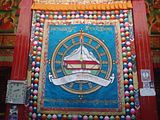
Our merry band of four next made its way past the queues to the main hall of Sera Monastery. The so-called Coqen Hall, which was built in 1710, is a four-storey building in the northeast area of the monastery. This main assembly hall, where various rituals are held, is supported by 125 pillars of varying heights and covers about 2,000 square meters (0.5 acre). It consists of five chapels which give honor to the Maitreya, Sakyamuni, Arhats, Tsongkhapa, and Kwan-yin with one thousand hands and eleven faces. We’d seen all these people walking away from the monastery with a large black spot on their forehead. At first I thought it must be some birth defect, but in the main hall we found out that it’s in fact applied by monks – after viewing the horse-headed Avalokitesvara you’re blessed with a dot (which we kindly refused).
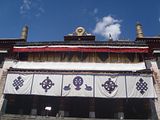
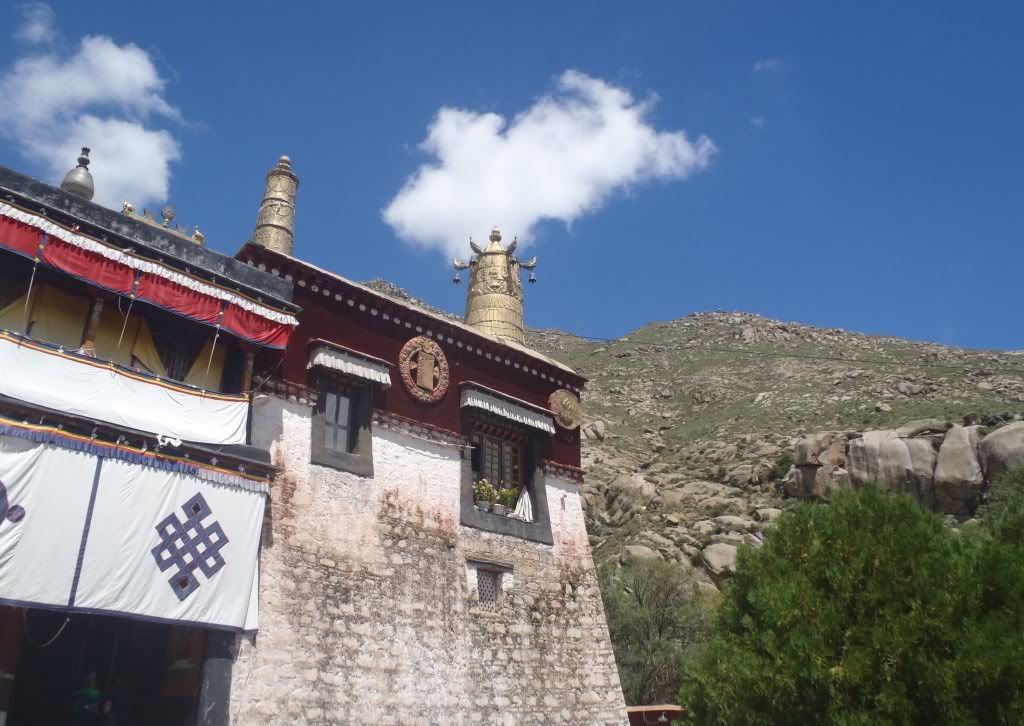
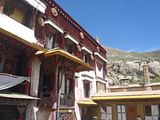
Another reason – perhaps the most important one – we’d come to Sera at this hour of the day were the monk debates. Every day, for about an hour, a group of at least 30 monks come together to discuss the teachings of Buddha and the philosophy of Buddhism. Today there were a few more than that, attracting an equally large number of tourists. Debate is an integral part of a Tibetan monk’s training, and is an effective means of training the mind and increasing mental sharpness. Ray told us they quiz each other on their knowledge of Buddhism and sometimes ask extremely interesting questions such as: “What color is a horse? Is it brown because of its fur, or perhaps red because of its blood or maybe it’s white since the bones are all that remains of a horse after some time?” Topics also arise from lessons learnt/discussed earlier that day in class.
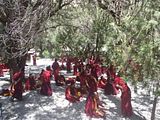
The first thing we noticed was the ferocity with which some monks were debating. The defender, sitting down, is usually a novice, while the questioner is a more experienced debater. Here’s a description from Snow Crest Inn’s website:
“The style of the debate follows a precisely choreographed routine beginning with a ritual invocation of Manjrushri, the boddhisattva of wisdom, in a loud high pitched tone.
Then the questioner, who is standing, begins the questioning in a very low and barely audible voice. He bends gently forward toward the defender, who is sitting, as a sign of humility and respect. At this point, the questioner is wearing his robe in the customary style, with the left shoulder covered, and the right shoulder bare. These initial gestures and soft speech are part of a skillful strategy designed to bring about a false sense of security in his opponent.

The defender presents his thesis. The questioner raises doubts. As the back and forth exchange of questions and answers progresses, the debate grows increasingly animated, impassioned, and physically intense, with plenty of forceful clapping and spirited verbal exchanges.
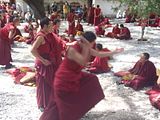
If the questioner has been able to draw the defender into making errors and contradicting himself, the questioner wraps his upper robe around his waist, as a sign of his understanding and control. No longer bending forward, he stands tall and makes forceful sweeping gestures, clapping his hands loudly to stress the power and decisiveness of his arguments."
Furthermore, here’s a list explaining the different movements we saw the monks make:
• “Putting the left hand forward symbolizes closing the doors to the lower states of rebirth.
• Clapping 2 hands together represents the union of the two aspects of the path: wisdom and method (i.e., compassionate actions).
• Drawing back the right hand signifies a wish to liberate all sentient beings.
• Circling the opponent’s head three times with the right hand, while speaking in a decisive and forceful voice, “These are the three circles.” (‘di ‘khor gsum) indicates the defender has made a mistake or a false argument.”
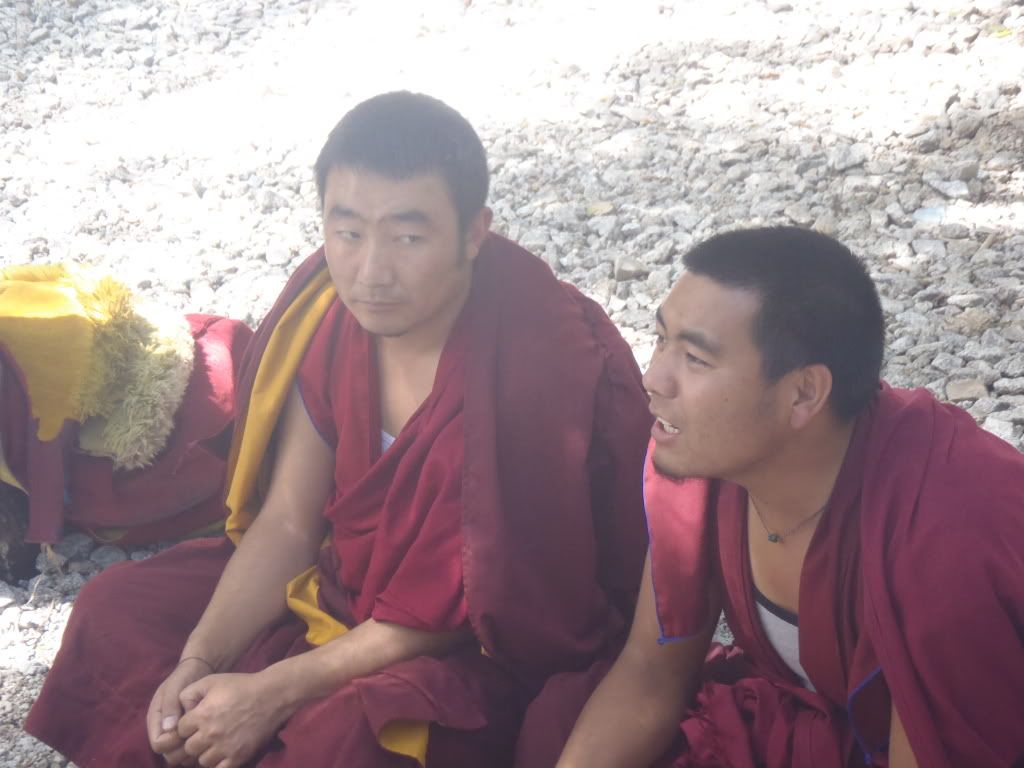
Whilst I walked around for a while, taking pictures and making movies Francesca and Sam sat down and watched a particularly ferocious monk. After scrutinizing the monks for well over 30 minutes we gave up. Since we couldn’t understand a word it eventually lost its charm. Besides, lunch beckoned. Having found out that out of the few decent restaurants in town only Snowland’s restaurant provided decent service we headed there for our chow. Francesca and Sam both had a cheese and tomato pizza that tasted pretty bad. Ray and I got ourselves a much tastier yak steak.
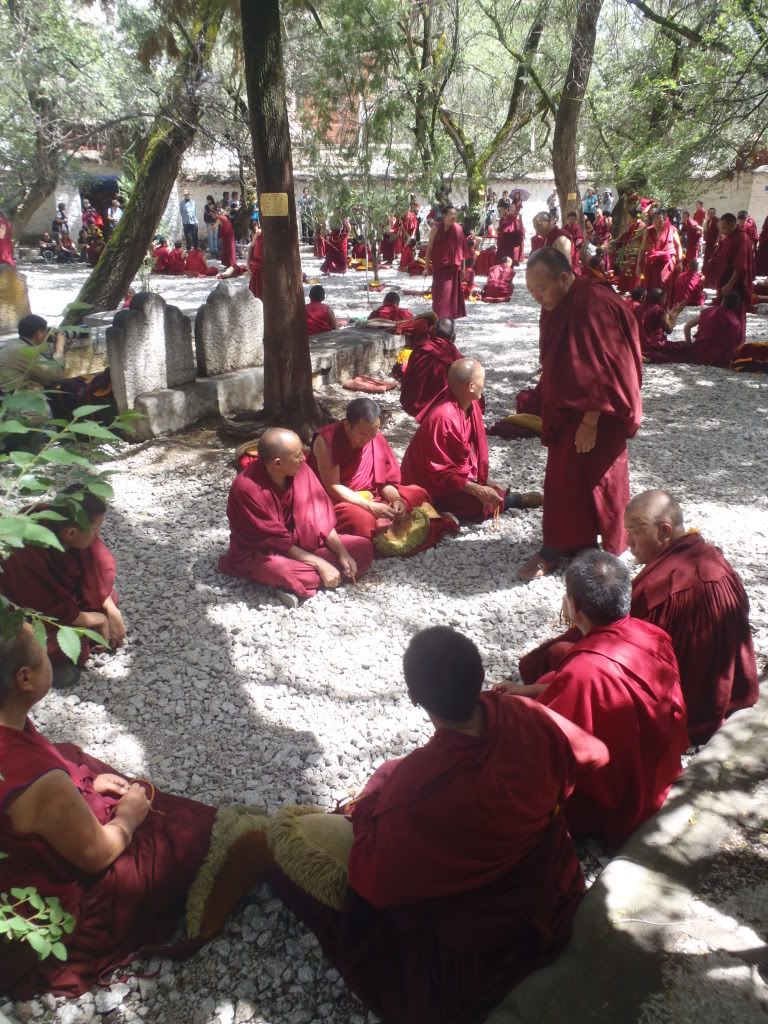
After our late lunch Francesca and Ray headed for the Ani Tsankhung Nunnery. Sam wasn’t feeling too great and I had to get the cash together to pay for the remainder of our tour, so we headed back to Rama Kharpo together. Francesca later told me she’d learned that the little nunnery had been built in the 7th century by Songsten Gampo, who used its meditation chamber. She got to see the nunnery's main hall, which contains a beautiful image of Chenrezi, the multi-armed bodhisattva of Compassion. Although we didn’t eat there, Francesca said the nuns ran their own small vegetarian restaurant, which looked promising.
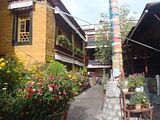
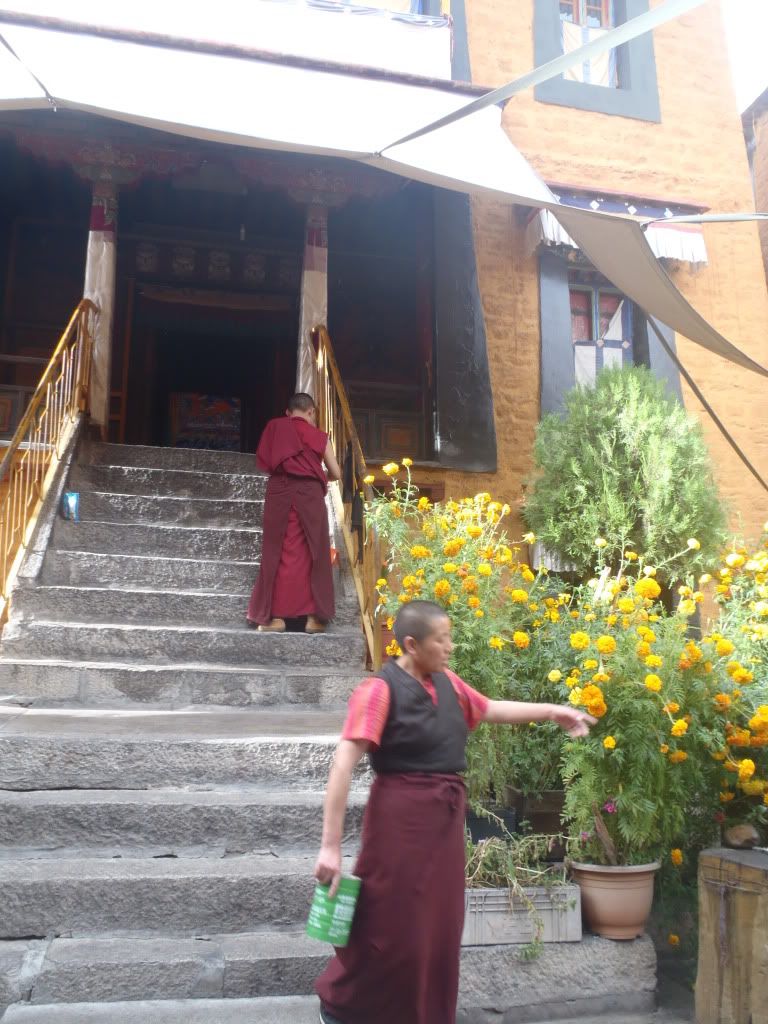
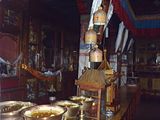
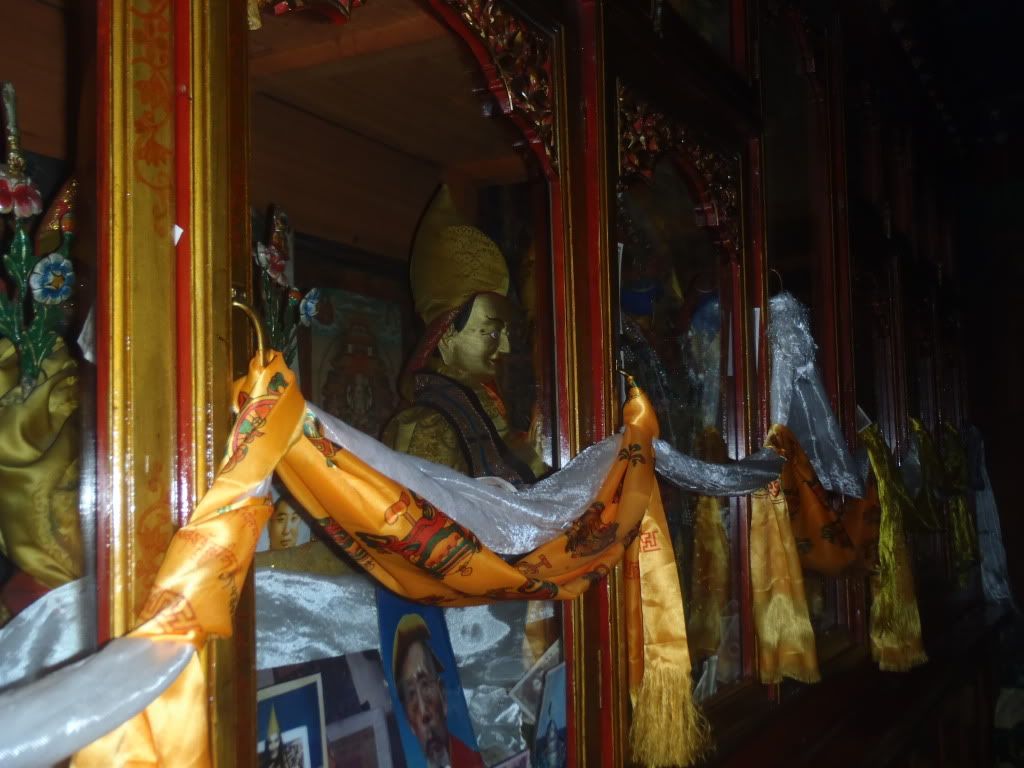
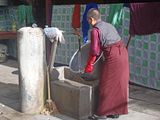
Just after 6:00 PM we all met up at the hotel and we handed over the money to Ray. Dinner that night was left-over pizza and some sandwiches, put together from the large stack of groceries we’d purchased earlier that day. We’d be leaving Lhasa that following day and especially Francesca felt she’d need provisions to make it through the promised monotony of available food on the road.
Instead of getting up terribly early we slept in, ordered breakfast in bed and didn’t meet Ray and Sam until 1:30 PM. Ray told us we had to take a taxi to the monastery of the day: Sera Monastery. A quick walk through the Muslim Quarter later we were by the side of the road, and soon found a taxi to take us to the designated location. Francesca asked me to take a picture of the highly valuable commodity all men in the quarter seem to be trading: cordyceps. Cordyceps is a caterpillar fungus that turns its host into a drone. After its death the fungus continues growing and in the process becomes a highly sought after ingredient of Tibetan traditional medicine. The street value of this stuff can be as much as $5000 per kilo!

Sera Monastery would be the second of the three great Gelugpa university monasteries we’d be able to see on our trip through Tibet. The first one had been Drepung, the monastery we’d only walked past on our way to the Shoton Festival. Since this monastery has an intensely rich history that is only poorly told without proper introduction to Tibetan Buddhism, allow me to pull together some interesting information. Hopefully it’ll help you understand this intricate way of life.
From Francesca you learned that Princess Wencheng, one of King Songtsen Gampo’s wives, came to Tibet with a statue of Shakyamuni Buddha. It’s not known whether Buddhism had a large following at this time. It is however clear from Tibetan sources that some of his successors became ardent Buddhists. Francesca also told you that Songtsen Gampo also married a Nepalese Buddhist princess, Bhrikuti. Wiki: “By the second half of the 8th century he was already regarded as an embodiment of the bodhisattva Avalokitesvara. The successors of Songtsen Gampo were less enthusiastic about the propagation of Buddhism but in the 8th century, King Trisong Detsen established it as the official religion of the state. He invited Indian Buddhist scholars to his court. In his age the famous tantric mystic Padmasambhava (known as Guru Rinpoche in Tibet) arrived in Tibet according to the Tibetan tradition. At this early time also, from the south came the influence of scholars under the Pala dynasty in the Indian state of Magadha. They had achieved a blend of Mahayana and Vajrayana that has come to characterize all forms of Tibetan Buddhism.” According to Mahayana Buddhism one should to attain enlightenment whereas Vajrayana Buddhists strive to attain enlightenment as quickly as possible in this very life.
Obviously, with this many different sources to work with it was inevitable Tibetan Buddhism became divided. Several important Buddhists had their own ideas about the right paths to follow and started their own schools, propagating their truth. Since all Monasteries we are going to tell you about are directly influenced by the school they’re part of it will be necessary to explain a little about the four different branches of Tibetan Buddhism. Here follows a summary based on information from Wikipedia and Buddhism.about.com.
The Nyingma tradition is the oldest of the four major schools of Tibetan Buddhism. ”Nyingma" literally means "ancient," and is often referred to as the "school of the ancient translations" or the "old school" because it is founded on the first translations of Buddhist scriptures from Sanskrit into Tibetan, in the eighth century. It claims as its founder Guru Rinpoche, "The Beloved Master," the man that King Trisong Detsen brought to Tibet in the 8th century.
The Kagyupa School, also known as the "Oral Lineage" or “Whispered Transmission” school, primarily follows the Vajrayana or Tantric teachings. Kagyupa is best known for its system of meditation and practice called Mahamudra. Some accounts name Marpa "The Translator" (1012-1099) as the founder of the School, while others name Gampopa (1084-1161), also known as Dagpo Lhaje, who was a student of Marpa's disciple Milarepa, as the founder.
The Sakya tradition developed during the second period of translation of Buddhist scripture from Sanskrit into Tibetan in the late 11th century. It was founded by Drogmi, a famous scholar and translator. The School is also one of the Red Hat sects (named after the color of the hats the monks wear) along with the Nyingma and Kagyupa.
Finally, the Gelugpa Sect, also known as the Yellow Hat Sect (guess what color their hats are!), is a school of Buddhism founded by Lama Tsongkhapa (1357–1419), a philosopher and Tibetan religious leader. The Gelugpa School places great emphasis on monastic discipline and sound scholarship. Also, the Dalai Lamas come from the Gelugpa School. We’ll tell you more about the Dalai Lamas and their history in upcoming posts, so fret not! Besides, after this wave of information your heads must be spinning already. Let’s return to the matter at hand: our visit to Sera Monastery.

Whilst walking uphill towards the first interesting buildings Ray told us that one of Tsongkhapa’s eight disciples founded Sera in 1419. Sera Monastery became famous for its tantric teachings, while Drepung Monastery drew fame from its governing role. We learned that the name ‘Sera’ comes from the landscape surrounding the monastery, which in spring and summer is covered in wild roses (‘se ra’ in Tibetan). In earlier days the monastery had been home to over 5500 monks. Up until 2006 there were still about 1000 of them left, but some of them mysteriously disappeared, leaving Sera with only several hundred residing monks.

Sadly, the Monastery suffered greatly during the Cultural Revolution (thank you so much Mao Zedong!), losing several colleges and seeing hundreds of monks die at the hands of the Chinese. As with most other Monasteries, structures were rebuilt, but invaluable knowledge and artifacts still vanished from the earth forever.
Entering that first unassuming building the three of us were immediately blown out of the water by what we got to see. Several glass cages showcased these extremely intricate, colorful works of art. ‘Mandalas’ is what they are called, and they’re made from colored sand. Themes differ, but always involve some deities (sometimes up to 722!) or Buddhist teachings. Ray told us one mandala can take four monks up to five days to make. Interestingly, most sand mandalas are destroyed shortly after their completion. This is done as a metaphor of the impermanence of life. Just look at these pictures – can you begin to imagine how much work goes into these things?




Inside the following building a father and son were hard at work. Most, if not all monasteries in Tibet have their own libraries, but only few monasteries still make their own books. Sera is one of those places where a traditional press house is still in use. Pages are copied by inking a piece of wood carved with the required text, pressing a piece of paper on and rolling over it with something hard to get everything printed properly. And boy, did they have that down to an art! They must have been doing a page every second. The texts they copied are either Buddha’s teachings or commentary on said teachings. Interestingly, the walls of the small building were lined entirely with racks and racks of inscribed wooden blocks. Quite impressive! Before exiting we also found a mural with a sword and a textbook as its centerpiece. Weird combination you’d say… Well, the sword is not used for fighting in the traditional way – instead, it’s to ‘cut’ ignorance from people and give them wisdom.



Our merry band of four next made its way past the queues to the main hall of Sera Monastery. The so-called Coqen Hall, which was built in 1710, is a four-storey building in the northeast area of the monastery. This main assembly hall, where various rituals are held, is supported by 125 pillars of varying heights and covers about 2,000 square meters (0.5 acre). It consists of five chapels which give honor to the Maitreya, Sakyamuni, Arhats, Tsongkhapa, and Kwan-yin with one thousand hands and eleven faces. We’d seen all these people walking away from the monastery with a large black spot on their forehead. At first I thought it must be some birth defect, but in the main hall we found out that it’s in fact applied by monks – after viewing the horse-headed Avalokitesvara you’re blessed with a dot (which we kindly refused).



Another reason – perhaps the most important one – we’d come to Sera at this hour of the day were the monk debates. Every day, for about an hour, a group of at least 30 monks come together to discuss the teachings of Buddha and the philosophy of Buddhism. Today there were a few more than that, attracting an equally large number of tourists. Debate is an integral part of a Tibetan monk’s training, and is an effective means of training the mind and increasing mental sharpness. Ray told us they quiz each other on their knowledge of Buddhism and sometimes ask extremely interesting questions such as: “What color is a horse? Is it brown because of its fur, or perhaps red because of its blood or maybe it’s white since the bones are all that remains of a horse after some time?” Topics also arise from lessons learnt/discussed earlier that day in class.

The first thing we noticed was the ferocity with which some monks were debating. The defender, sitting down, is usually a novice, while the questioner is a more experienced debater. Here’s a description from Snow Crest Inn’s website:
“The style of the debate follows a precisely choreographed routine beginning with a ritual invocation of Manjrushri, the boddhisattva of wisdom, in a loud high pitched tone.
Then the questioner, who is standing, begins the questioning in a very low and barely audible voice. He bends gently forward toward the defender, who is sitting, as a sign of humility and respect. At this point, the questioner is wearing his robe in the customary style, with the left shoulder covered, and the right shoulder bare. These initial gestures and soft speech are part of a skillful strategy designed to bring about a false sense of security in his opponent.

The defender presents his thesis. The questioner raises doubts. As the back and forth exchange of questions and answers progresses, the debate grows increasingly animated, impassioned, and physically intense, with plenty of forceful clapping and spirited verbal exchanges.

If the questioner has been able to draw the defender into making errors and contradicting himself, the questioner wraps his upper robe around his waist, as a sign of his understanding and control. No longer bending forward, he stands tall and makes forceful sweeping gestures, clapping his hands loudly to stress the power and decisiveness of his arguments."
Furthermore, here’s a list explaining the different movements we saw the monks make:
• “Putting the left hand forward symbolizes closing the doors to the lower states of rebirth.
• Clapping 2 hands together represents the union of the two aspects of the path: wisdom and method (i.e., compassionate actions).
• Drawing back the right hand signifies a wish to liberate all sentient beings.
• Circling the opponent’s head three times with the right hand, while speaking in a decisive and forceful voice, “These are the three circles.” (‘di ‘khor gsum) indicates the defender has made a mistake or a false argument.”

Whilst I walked around for a while, taking pictures and making movies Francesca and Sam sat down and watched a particularly ferocious monk. After scrutinizing the monks for well over 30 minutes we gave up. Since we couldn’t understand a word it eventually lost its charm. Besides, lunch beckoned. Having found out that out of the few decent restaurants in town only Snowland’s restaurant provided decent service we headed there for our chow. Francesca and Sam both had a cheese and tomato pizza that tasted pretty bad. Ray and I got ourselves a much tastier yak steak.

After our late lunch Francesca and Ray headed for the Ani Tsankhung Nunnery. Sam wasn’t feeling too great and I had to get the cash together to pay for the remainder of our tour, so we headed back to Rama Kharpo together. Francesca later told me she’d learned that the little nunnery had been built in the 7th century by Songsten Gampo, who used its meditation chamber. She got to see the nunnery's main hall, which contains a beautiful image of Chenrezi, the multi-armed bodhisattva of Compassion. Although we didn’t eat there, Francesca said the nuns ran their own small vegetarian restaurant, which looked promising.





Just after 6:00 PM we all met up at the hotel and we handed over the money to Ray. Dinner that night was left-over pizza and some sandwiches, put together from the large stack of groceries we’d purchased earlier that day. We’d be leaving Lhasa that following day and especially Francesca felt she’d need provisions to make it through the promised monotony of available food on the road.

0 Comments:
Post a Comment
<< Home